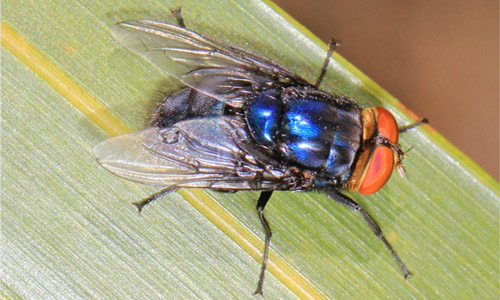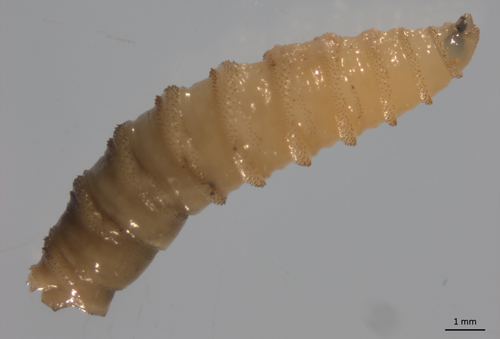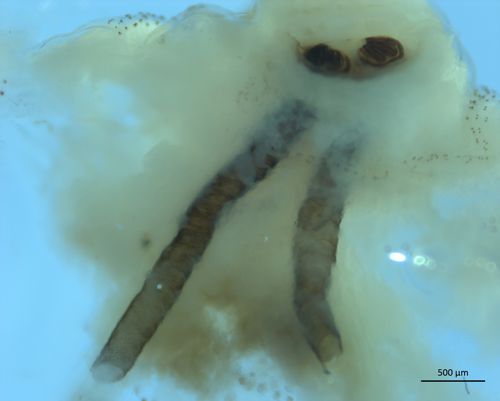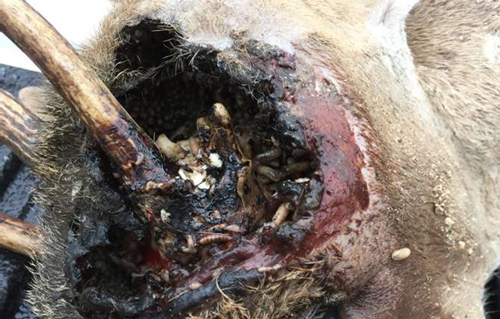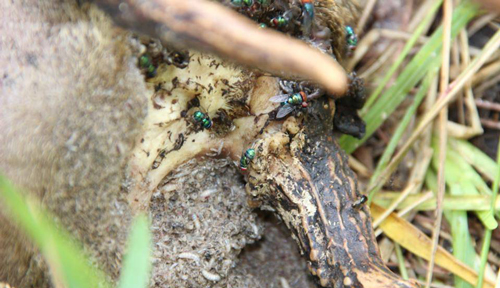common name: primary screwworm
scientific name: Cochliomyia hominivorax (Coquerel) (Insecta: Diptera: Calliphoridae)
Introduction - Distribution - Description - Life Cycle - Veterinary and Economic Importance - Management - Selected References
Introduction (Back to Top)
Screwworms are endemic to the Western Hemisphere and pose a serious threat to livestock, wildlife, pets, and humans (Williams et al. 1985; Mullen and Durden 2009; CABI 2016). The primary screwworm, Cochliomyia hominivorax (Coquerel) (Figure 1), also known as the New World screwworm, occurred in several areas of the southern United States before eradication efforts began in the 1950s (Krafsur et al. 1987). Although considered eradicated throughout most of North America, active infestations still occur in Jamaica, Cuba, and across South America. Typical insecticide suppression of the primary screwworm is not as effective as with other insect pests.
Along with other control measures, the release of sterile insects, known as the sterile insect technique or SIT, was used successfully in eradication efforts in North America (Vyrsen et al. 2007). In October of 2016, the USDA-APHIS (United States Department of Agriculture-Animal and Plant Health Inspection Service) confirmed the presence of primary screwworm in Key deer (Odocoileus virginianus clavium) on Big Pine Key in Florida. Key deer are an endangered species that have been found only on the Florida Keys, and several have died or been euthanized due to the 2016 screwworm infestations (FDACS 2016). A second screwworm species, the secondary screwworm, Cochliomyia macellaria (Fabricius) also is found in Florida; however, this species only infests dead animals or animals already harboring primary screwworm infestations (Byrd 1998).
Figure 1. Adult screwworm, Cochliomyia hominivorax (Coquerel). Note the dark stripes across the backline (thorax) of the fly behind the head. Photograph by Judy Gallagher.
Distribution (Back to Top)
The current distribution of Cochliomyia hominivorax is primarily south of the Darién gap in southern Panama, including much of South America, and on a few Caribbean islands, notably Jamaica and Cuba (Welch 2016). For a detailed distribution map please refer to the CABI Screwworm Datasheet. At this time, the outbreak in the Florida Keys is considered to be confined and under quarantine (FDACS 2016). Outside of the United States, introductions or re-introductions, followed by eradication, have occurred in Aruba, Australia, Curacao, Libya, Mexico, and Panama (Welch 2016).
Description (Back to Top)
The adult primary screwworm, Cochliomyia hominivorax is a metallic blue fly with three stripes that run down the top (dorsal surface) of the fly just behind the head, and orange eyes (Figure 1). The center stripe begins partway down the backside and appears shorter than the outer stripes. Adults are roughly 2 to 3 times the size of a house fly. This fly may easily be confused with the secondary screwworm, which also has three lines; however, all three lines begin at the same point behind the head on the secondary screwworm.
Larvae (Figure 2) found in an animal wound can reach 17 mm in length (2/3 of an inch). The most mature larvae develop spines that protrude from the body and wrap around in a spiral, hence the name screwworm (Hall 1991). Identification of the larvae is based largely on the presence or absence of internal breathing tubes and requires a trained entomology specialist for confirmation (Figure 3).
Figure 2. Larval primary screwworm, Cochliomyia hominivorax (Coquerel). Photograph by Heather Stockdale Walden, University of Florida.
Figure 3. Dissection of internal darkened breathing tubes (trachea) from the larva of a primary screwworm, Cochliomyia hominivorax (Coquerel). This feature is used to differentiate primary screwworm larvae from secondary screwworm larvae. Photograph by Heather Stockdale Walden, University of Florida.
Life Cycle (Back to Top)
Primary screwworm infestations begin when an adult female fly deposits eggs in an existing wound on an animal. Such wounds can be as small as a tick bite. A single adult female can lay as many as 350 eggs, but not all eggs are deposited in a single wound. The fly only lays its eggs on living animals, differentiating it from all other blow flies in the Americas. These eggs hatch, and the larvae feed on the healthy tissue, causing the wound to enlarge. Their activity can draw in more adult flies, including those of other blow fly species, that can deposit more eggs. Once larvae are fully formed, they drop to the ground where they pupate in the leaf litter or upper soil levels. Adult flies will emerge from the pupae 7 to 10 days later and begin the cycle again. In ideal environmental conditions, primary screwworms can complete their life cycle in 24 days (Laake et al. 1936).
The primary screwworm is not capable of overwintering in areas that experience low temperatures or extended dry periods. Interestingly, most screwworm females only mate once, making them an ideal candidate for the sterile insect technique described below.
Veterinary and Economic Importance (Back to Top)
Adult primary screwworms, like all blow flies, do not bite animals. Their damage is done through the feeding of the larvae on the wounds of living animals. Screwworms can infest all types of mammals and other warm-blooded animals, including livestock, wildlife, pets and even humans, although they are rarely found in birds. Wild and captive-raised deer also can be affected. Infestation generally occurs at the site of a recent, existing wound, such as a scrape, lesion or even tick feeding site, but also from castration, dehorning, branding, ear tagging, or shearing. In addition, mucous membranes and antlers that are shedding velvet are potential sites of infection. In newborn mammals, it often infects the site of the healing umbilical cord.
Because pets can become infested, it is important that owners watch any wounds that do not heal properly. Larvae may not be apparent and a veterinarian should be consulted in such situations. Examination of wildlife is challenging and should be conducted by professionals. If you suspect an infestation of any wildlife, you should contact local Florida Fish and Wildlife Commission personnel.
Figure 4. Small lesions on a Key deer (Odocoileus virginianus clavium) killed by primary screwworm, Cochliomyia hominivorax (Coquerel), with other blow fly adults visiting the carcass. Samantha Gibbs, U.S. Fish and Wildlife Service.
The early stages of an infestation are difficult to detect (Figure 4). Wounds that are not properly healing or that are draining excessively should be inspected for larvae. Animals may show discomfort and become lethargic when infested. Wounds that are not treated can become life threatening in 7 to 14 days. Any suspected or discovered case of larvae in a live host must be reported to the Florida Department of Agriculture and Consumer Services. Infested animals should not be moved to ensure that flies are not moved to uninfested areas.
Management (Back to Top)
The following information was provided by FDACS on 04 Oct. 2016: Residents who have warm-blooded animals (dogs, cats, livestock, horses, birds, etc.) should check their animals carefully and report any potential cases to 1-800-HELP-FLA (1-800-435-7352) or non-Florida residents should call (850) 410-3800. All individuals headed north from Key Largo with warm-blooded animals are required to stop at the animal inspection facility that has been established to prevent the spread of the infestation. If you are in Monroe County, Florida, please contact the UF/IFAS Monroe County Extension office for additional information.
Treatment of the Individual
Consult with your veterinarian for the appropriate treatment. The larvae should be removed with forceps and the wound cleaned. If you suspect screwworm (the presence of flesh-eating larvae is the surest sign), collect the larvae in alcohol and give them to your veterinarian immediately. Your veterinarian will submit them to the USDA’s National Veterinary Services Laboratory for identification. After removal, infestations often are treated topically with a pesticide to kill any larvae that may not have been removed and to reduce the likelihood of reinfestation.
It is exceedingly important to report any infestations to Florida Department of Agriculture and Consumer Services. They will assist animal owners in the treatment of infested animals and remove flies from the vicinity. The primary screwworm can quickly devastate flocks or herds and, in the past, has cost the U.S. livestock industry billions of dollars. A reported case will not result in herd depopulation, but will allow animal health officials to take steps on your ranch to help you protect your herd.
Several traps exist for monitoring primary screwworm adults; these are generally sticky traps baited with an attractant lure (swormlure-4) (Broce et al. 1977). These traps are often used to monitor for the flies to ensure that sterile insect programs are working to provide area-wide control of screwworms (Vreysen et al. 2007).
Following initial colonization of the primary screwworm, other blow fly species may be attracted to the wound (Figures 4 and 5). These non-screwworm blow flies may lay eggs in the same wound and thus one may see other types of blow fly adults and their larvae on the animals, particularly as the animal’s health declines.
Figure 5. A Key deer (Odocoileus virginianus clavium) killed by primary screwworm, Cochliomyia hominivorax (Coquerel), with other blow fly adults visiting the carcass. Samantha Gibbs, U.S. Fish and Wildlife Service.
Historical Management and Eradication
Prior to the 1950s and 60s, primary screwworms were a major economic burden to the production and treatment of livestock in the southwestern United States and Florida. In the late 1950s, the USDA began implementing an eradication strategy based on releasing sterile male flies in the environment along with reducing infestations by continuous animal monitoring. The sterile males, released in numbers far exceeding the normal population levels, competed with fertile males to mate with females. Because females only mate once, any fly that mated with a sterile male will be unable to produce offspring which results in the eventual elimination of the fly.
Using sterile male flies, the primary screwworm was eradicated in Florida in 1960. The screwworm was not eradicated from the rest of the United States until 1983 because of ongoing incursions of flies from Mexico (Novy 1991). Due to the wide success of this program and in cooperation with our southern neighbors, the primary screwworm has been eradicated from North America down to a zone south of the Panama Canal.
Management of the Current Outbreak
As of October 04, 2016, the current primary screwworm outbreak is confined to Monroe County on Big Pine Key. An agricultural emergency has been declared for Monroe County. Eradication of the flies is occurring in the affected area, and an animal quarantine and Animal Health Check Station is in effect for the area (see FDACS Proclamation for details). As of the publication of this document, the USDA is preparing to release sterilized male primary screwworms in the area of the current outbreak to eradicate the infestation.
Is a pet or other animal exhibiting signs of screwworms?
Email a photo to AgVeterinarians@FreshFromFlorida.com and FDACS veterinarians will review the photo and respond to you. Write "Please review this photo for screwworm" in the subject line.
If you are in Monroe County, Florida, please contact the UF/IFAS Monroe County Extension office for additional information.
Selected References (Back to Top)
- Broce AB, Goodenough JL, Coppedge JR. 1977. A wind oriented trap for screwworm flies. Journal of Economic Entomology 70: 413-416.
- Byrd JH. 1998. Secondary screwworm, Cochliomyia macellaria (Fabricius). UF/IFAS Featured Creatures Document ENY-22. Revised August 2014. (04 October 2016)
- Dyck VA, Hendrichs J, Robinson AS. 2005. Sterile Insect Technique: Principles and Practice in Area-wide Integrated Pest Management. Springer, Dordrecht, the Netherlands. 787 pp.
- Florida Department of Agriculture and Consumer Services. 2016. USDA confirms New World screwworm cases in Big Pine Key. FDACS Press Release. (04 October 2016)
- Hall DG. 1948. The blow flies of North America, Thomas Say Foundation Publication vol. 4. Entomological Society of America, Lanham, MD. Publishers.
- Hall MJR. 1991. Screwworm flies as agents of wound myiasis. World Animal Review: Special issue: New World screwworm response to an emergency. Oct: 08-17.
- James MT. 1947. The flies that cause myiasis in man. United States Department of Agriculture Miscellaneous Publication No. 631. 175 pp.
- Krafsur ES, Whitten CJ, Novy JE. 1987. Screwworm eradication in North and Central America. Parasitology Today 3(5): 131-137.
- Laake EW, Cushing EC, Parish HE. 1936. Biology, of the primary screwworm fly, Cochliomyia americana, and a comparison of its stages with those of C. macellaria. USDA Tech. Bull. No. 500. Washington, D.C., USDA.
- McAlpine JF. 1987. Manual of Nearctic Diptera, Volume 2. Canada Communication Group, Ottawa, Canada. 1332 pp.
- Mullen GR, Durden LA. 2009. Medical and Veterinary Entomology (2nd ed.). Elsevier, London, UK. 637 pp.
- Novy JE. 1991. Screwworm control and eradication in the southern United States of America. World Animal Review: Special issue: New World screwworm response to an emergency. Oct: 18-27.
- Taboada O. 1966. Medical Entomology. Naval Medical School 1967. U.S. Government Printing Office, Washington D.C. 395 pp.
- Vreysen MJB, Robinson AS, Hendrichs J. 2007. Area-wide Control of Insect Pests: From Research to Field Implementation. Springer, Dordrecht, the Netherlands. 789 pp.
- Welch JB. (2016). Cochliomyia hominivorax (New World screwworm) datasheet. CABI Invasive Species Compendium. (04 October 2016)
- Williams RE, Hall RD, Broce AB, Scholl PJ (Eds.). 1985. Livestock Entomology. Wiley, New York, USA. 335 pp.
